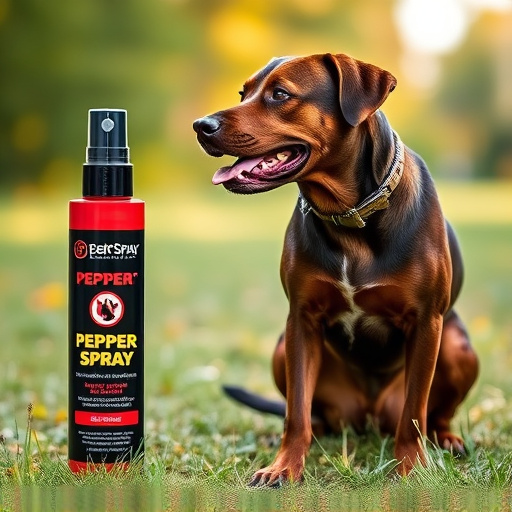Mace canine spray, a non-lethal defense against aggressive dogs, disrupts their senses with capsaicin mist. Pattern width varies by brand and conditions, crucial for effective deployment targeting eyes and face. Safety requires understanding manufacturer instructions, training, and legal considerations in using this tool responsibly.
In today’s world, dog owners are increasingly turning to innovative self-defense tools like mace canine spray to protect their pets. Understanding the mechanisms behind this powerful defense is crucial for its effective and safe usage. This article explores how mace spray works, focusing on key factors such as Mace Canine Spray pattern width and its effectiveness. We also delve into best practices for training, legal considerations, and practical tips for dog owners looking to enhance their pet’s safety.
- Understanding Dog Pepper Spray Defense Mechanisms
- How Mace Canine Spray Works and Its Effectiveness
- Evaluating Pattern Width for Optimal Protection
- Safe Use and Training Practices for Dog Owners
- Legal Implications of Pepper Spray on Dogs
Understanding Dog Pepper Spray Defense Mechanisms
Dog pepper spray defense mechanisms are a crucial aspect to understand when considering personal safety. Pepper spray, also known as mace, is an effective deterrent against aggressive dogs due to its unique chemical composition and application method. When deployed, the spray creates a mace canine spray pattern with a specific width, temporarily blinding and disorienting the targeted animal. This disruption in their normal sensory perception enables the user to create distance or seek assistance without being seriously harmed.
The key to successful dog pepper spray defense lies in understanding the spray’s reach and effectiveness. The Mace canine spray pattern width varies depending on factors like the brand, concentration, and weather conditions. Users should familiarize themselves with the manufacturer’s instructions and practice targeting techniques to ensure optimal coverage area. Effective deployment requires a swift and accurate motion, aiming for the dog’s face and eyes, where it can cause the most discomfort and temporarily disable their attack capabilities.
How Mace Canine Spray Works and Its Effectiveness
Mace canine spray, a non-lethal deterrent, is designed to temporarily incapacitate and control aggressive dogs. When activated, the spray releases a fine mist containing capsaicin, the active ingredient found in chili peppers. This irritant targets the dog’s eyes, nose, and respiratory system, causing temporary blindness, coughing, and difficulty breathing. The spray’s pattern width, typically around 3 meters (10 feet), ensures a wide area of coverage, making it effective for deterring multiple dogs at once.
The effectiveness of Mace canine spray lies in its ability to disrupt a dog’s behavior quickly. The initial burst of spray can startle the animal, allowing the owner or handler time to regain control or seek assistance. However, success depends on proper usage, including aiming accurately and ensuring adequate training for both the user and the dog. Regular practice with the spray is crucial to familiarize with its range and functionality, enhancing overall safety during potential encounters with aggressive canines.
Evaluating Pattern Width for Optimal Protection
When considering dog pepper spray defense, understanding the spray pattern width is crucial for optimal protection. The Mace Canine Spray is designed to create a cone-shaped cloud of oleoresin capsicum (OC), which disrupts an aggressor’s senses and allows the protected individual time to escape. The ideal pattern width ensures maximum coverage while minimizing OC exposure to bystanders or non-target areas, making it safer for both the user and those around them.
Evaluating the spray pattern width involves considering factors such as distance and angle of application. Users should practice with the spray device in controlled environments to determine the effective range where the OC cloud maintains its potency while remaining contained within a safe perimeter. This knowledge enables users to deploy the spray accurately, enhancing their ability to deter potential threats and protect themselves effectively.
Safe Use and Training Practices for Dog Owners
Dog owners considering pepper spray as a defense option must prioritize safety and responsible use. Familiarize yourself with local laws regarding the possession and use of canine spray, ensuring compliance to avoid legal repercussions. Startle or distraction techniques are often more effective than aiming directly at an aggressor’s face—a practice that reduces the risk of harm to both you and the dog.
Training is key; teach your dog basic commands like “sit,” “stay,” and “leave it” to establish control. Practice in controlled environments, gradually introducing potential triggers. When using Mace canine spray, understand its pattern width and range: a typical stream covers about 2-3 feet, so aim for the face or nose area of an attacking dog, creating a break in their concentration. Regularly review safety protocols with your pet to ensure responsible and effective use in case of an emergency.
Legal Implications of Pepper Spray on Dogs
The use of pepper spray, or Mace canine spray, as a defense mechanism for dogs has raised legal questions and concerns. When deployed, this spray creates a narrow pattern with a specific width, aiming to temporarily incapacitate an attacker without causing severe harm. However, its legality varies across jurisdictions, with some regions permitting its use in self-defense scenarios involving animals.
The implications extend beyond the immediate incident. Dog owners or handlers using pepper spray must be aware of local laws and regulations, as misuse or inappropriate deployment could lead to legal repercussions. Cases have shown that the pattern width and effectiveness of the spray must align with the perceived threat, ensuring a reasonable response in line with self-defense principles.
Dog pepper spray, such as Mace Canine Spray, offers a powerful defense mechanism for both owners and their pets. Understanding how it works, its effectiveness in terms of pattern width, and safe usage practices is crucial. By evaluating the spray’s reach and employing proper training, dog owners can ensure optimal protection for themselves and their canines. Additionally, being aware of legal implications associated with its use further underscores the importance of responsible handling.
